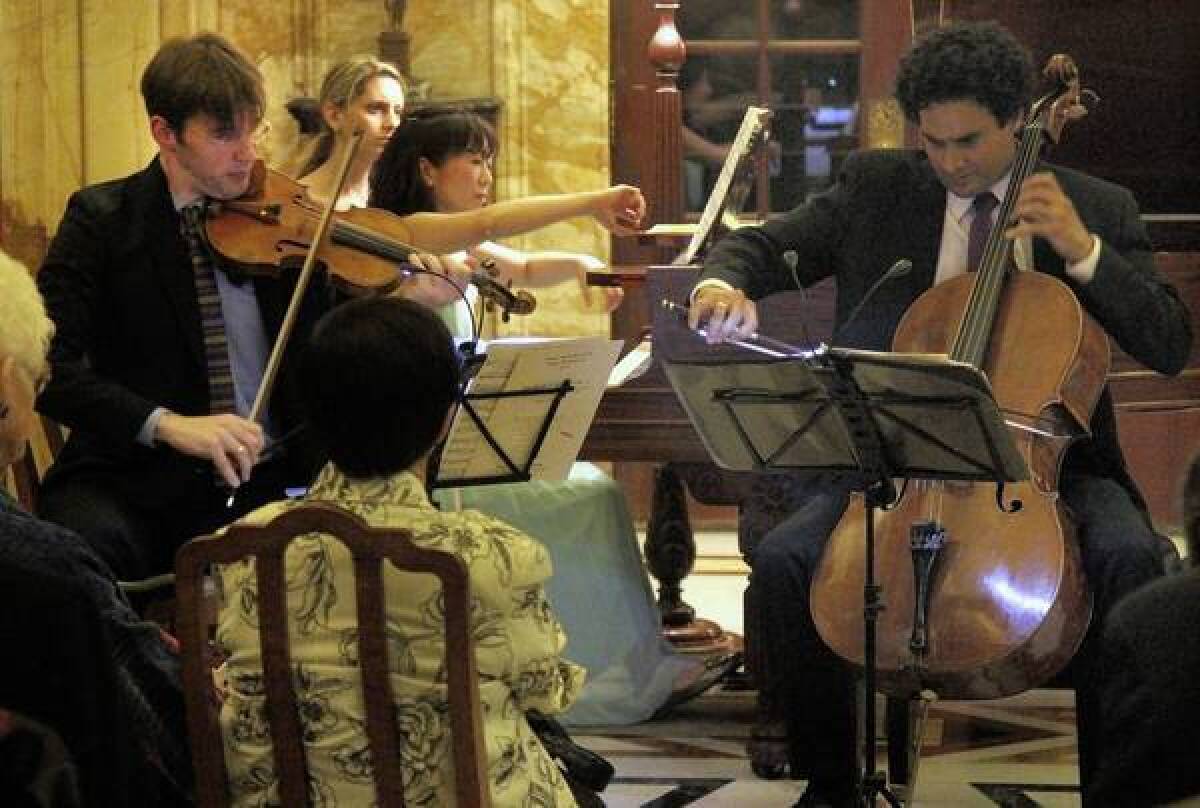Review: The Horszowski Trio’s commendable conviction

- Share via
Among the exceptional accomplishments of Mieczyslaw Horszowski, the Polish pianist who died in Philadelphia in 1993 one month before his 101st birthday, was marrying at 89, performing into his late 90s and teaching until the last week of his life. His students include such probing pianists as Murray Perahia, Richard Goode and Peter Serkin. In those final recitals, a revelatory Horszowski summoned, with fingers that preserved an incomparable historical memory, long-dead voices from another era.
The Horszowski Trio, which made its Los Angeles debut Friday night at the gilded Doheny Mansion at Mount St. Mary’s College to close the Da Camera Society season, has thus chosen surprising footsteps to follow. The combined ages of the players in the New York-based trio formed in 2011 barely surpasses the number of Horszowski’s years. The connection comes from pianist Rieko Aizawa, Horszowski’s last pupil. The ensemble is close-knit. Aizawa and violinist Jesse Mills are married. Cellist Raman Ramakrishnan is Mills’ childhood friend.
The program began with early piano trios by Saint-Saëns and Shostakovich, seldom played. Horszowski knew both composers. The big work was Dvorák’s Piano Trio No. 3, Opus 65, which has a glorious slow movement that was movingly played. Horszowski was almost 12 when Dvorák died in 1904.
PHOTOS: Arts and culture in pictures by The Times
The freshest work and the one that brought Horszowski most readily to mind was the Saint-Saëns. I’d never heard it live before and would never a year or two ago have sought it out. A seeming lightweight known for a handful of potboilers, Saint-Saëns is easy to dismiss.
But thanks in particular to pioneering work by the UC San Diego musicologist Jann Pasler and her epic 2009 “Composing the Citizen,” a brilliant study of the civic function of French music in the Third Republic, and of her recent volume to accompany a Saint-Saëns’ festival at Bard College last summer, many are suddenly talking about the composer as an unsung revolutionary.
And the Trio No. 1, written in 1863 when Saint-Saëns was 28, is a perfect example of why. It has, as much of Saint-Saëns does, enticing surface charm. But unbutton a single layer of the surface lace, and an unmistakable whiff of late Beethoven is released. Perfumed late Beethoven, perhaps, but that’s the beauty of Saint-Saëns’ allure.
The trio is thinly scored and, as with late Beethoven, one note is allowed to stand in for 12. There are clichés. Saint-Saëns loves running up and down scales on the piano. But he runs when you expect him to walk, and he walks when he could get to where he is going faster by running but would then not have time for a delicious little harmonic detour.
The Horszowskis are power players. The violinist and cellist both boast big, bold, dug-in tone. Aizawa’s sound is equal to theirs, but she, true to her mentor, is more grounded and less fervent, with no need to bring anything extraneous into her interpretations.
I could have used slightly more color, more contrast, more character, but not more conviction. The ensemble sold Saint-Saëns on the sheer, forthright scale of its playing.
PHOTOS: Hollywood stars on stage
It was that sound and strength that brought a rapt radiance to the dark embers of Dvorák’s slow movement, one of the composer’s most heartfelt and emotionally thick utterances. Opus 65 is the ensemble’s signature works, thus far, and the musicians make it memorably monumental.
Shostakovich’s short student trio, the effort of a lovesick 17-year-old with a Tristan complex that already sounds almost like Shostakovich, was also played to the hilt. But the trio is juvenilia.
For an American piano trio on the verge of an important career, there are American trios, mature masterpieces by Ives, Henry Cowell and Lou Harrison in far greater need of promotion. The Horszowski ensemble knows this. Its violinist, Mills, is a composer himself. The trio’s first recording is of a quirky new American work, “Lonesome Road” by Dan Visconti.
Let the Horszowskis bring on the quirk — as Horszowski did — and they’ll be on their way.
More to Read
The biggest entertainment stories
Get our big stories about Hollywood, film, television, music, arts, culture and more right in your inbox as soon as they publish.
You may occasionally receive promotional content from the Los Angeles Times.











